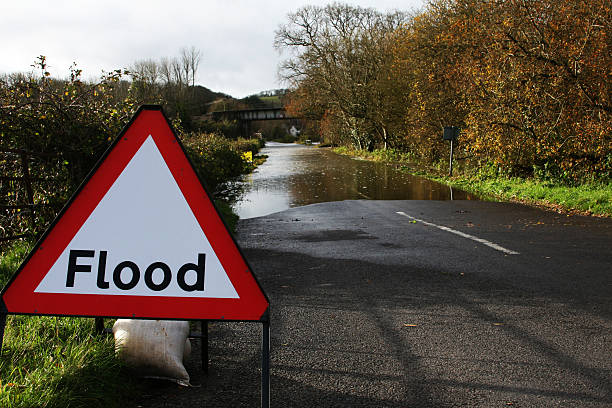Flooding is a severe problem for many people during autumn. When rivers rise unexpectedly, they can overflow their banks and flood homes. In addition, rainwater can also reach the coast through storm drains and cause coastal flooding.
Groundwater flooding is a common problem that can affect any home or business. Oftentimes, groundwater can leak into basements or crawl spaces through cracks in foundations. When this happens, it can cause significant damage to homes and businesses because it can flood the basement or crawl space, causing mould growth and structural damage. Groundwater flooding can be a much slower process, sometimes taking days, weeks, or even months to happen, and can last for just as long.
Many flood defences focus on what happens during river floods. However, groundwater flooding is very different and requires a different approach. Traditionally, flood protection measures only take into account the water level and flow rate of rivers, however, they often fail to consider how contaminants move through soil and infiltrate buildings. In addition, flood defences are designed to protect people and property from water damage, rather than prevent contamination from entering homes. As such, they may not provide adequate protection against groundwater contamination.
What is groundwater flooding?
Groundwater flooding is when water in the earth rises above the ground. Water tables can rise over a prolonged period of time, sometimes lasting for months before they reach the surface. When this happens, water can flow into buildings and homes. This is called groundwater flooding.
Perched water tables (also known as perched aquifers) are becoming increasingly common. These are where there is a temporary increase in the groundwater level due to rainwater entering the ground through cracks in the surface, or even a damaged drain or a mains water burst.
Groundwater tends to come through the floor and into your basement, so traditional flood prevention methods do not work very well against groundwater floods. Water can get into your house through the foundation walls, crawl space, or slab, causing damage. You may also see signs of mould growth if the water gets into your home.
Where is groundwater flooding most common?
In parts of England, the ground is prone to flooding, traditional landscapes including valleys and hillsides are more commonly associated with groundwater. However, cities aren’t immune either. Groundwater can rise in places with clay, sand, and gravel too.
London has a big groundwater water problem. While homes all over town are affected, it has turned into a significant issue for houses in Fulham, Hammersmith, Southwark, & Wandsworth. Heavy rain and rising groundwater levels are among the reasons why basements have started filling up over time.
Groundwater flooding is an issue that homeowners face every day. However, before taking action, it is important to know what types of problems may occur and how they can be addressed.
The warning signs you need to watch out for-
River flooding, coastal floods, surface water floods, and reservoir floods are all very different to groundwater flooding. When most people consider flooding, they picture streets flooded with water or the water entering homes through doors. Groundwater is a completely different matter and can cause severe damage to properties and disrupt lives. However, there are a few warning signs that can help you identify if you might be at risk of being affected by flood waters.
- Local sewers are overloading and overflowing
- Damp patches appearing in lower levels of the property
- Water in your cellar/basement with no source
The code of practice covering flooding in below-ground structures states that risk should be taken for any basement or cellar. Even if there aren’t any indicators at present, problems could arise in the future. Recently severe weather conditions have revealed many unprotected basements, meaning if your basement is presently unprotected then now is the right time to consider waterproofing.
How should you manage groundwater flooding?
Flooding prevention is dependent upon the kind of flooding you wish to avoid. Traditional flood protection methods such as sandbagging cannot stop groundwater from rising into your house. Groundwater rises slowly, so you may not notice any changes until a major problem occurs. You might also experience minor problems if you live near a river or lake. Water levels rise quickly during heavy rainstorms.
When it comes to water management and flood protection, there are different solutions available to you. What works best for your property will depend on various factors, so getting an expert to assess your situation can help you find the right answer for you.
Type A Barrier System (Tanking)
A tanking slurry or waterproof render may be used to protect against groundwater penetration into basements. However, relying solely upon such a technique to prevent water damage to your property can be risky.
In order to get a successful rendering job, it is vital to establish a strong bond between the wall and the render coat. This can often be difficult because bricks are very hard, and they do not naturally adhere to render coats. If the bond is not obtained, this can lead to failure of render coats, dampness, and potentially flooding if it fails. Structural movement can also cause renders to crack.
Type C Cavity Drainage Membrane
One of the most common solutions is the Type C cavity drain system, an industry-standard recognized as the more reliable option. A key benefit of this system is that you can test it out before installing it into your home, meaning you’ll know it will perform properly when needed.
A polymer studded wall is installed on the floor, and drainage channels lead to a sump and drain or existing drainage system. The water enters the basement through these channels and drains out through an outlet located near the surface. Because this method does not require any structural changes to the foundation, it has become popular among homeowners who wish to add usable space to their basements without having to tear up their floors.
Why groundwater flooding is a risk you need to be aware of
In addition to being used as a tool for planning, flood mapping also plays an important role in flood prevention. While many people think about floods occurring during heavy rain events, they should also consider the possibility of rising water tables. Rising water tables mean that it is possible for your home to flood weeks, months, or even years after rainfall begins to occur. You can learn more about how to prevent flooding by reading our article on how to protect against flood damage.
Written by Joey Miller.
Author at London Waterproofing Solutions, groundwater and waterproofing specialists in London.















